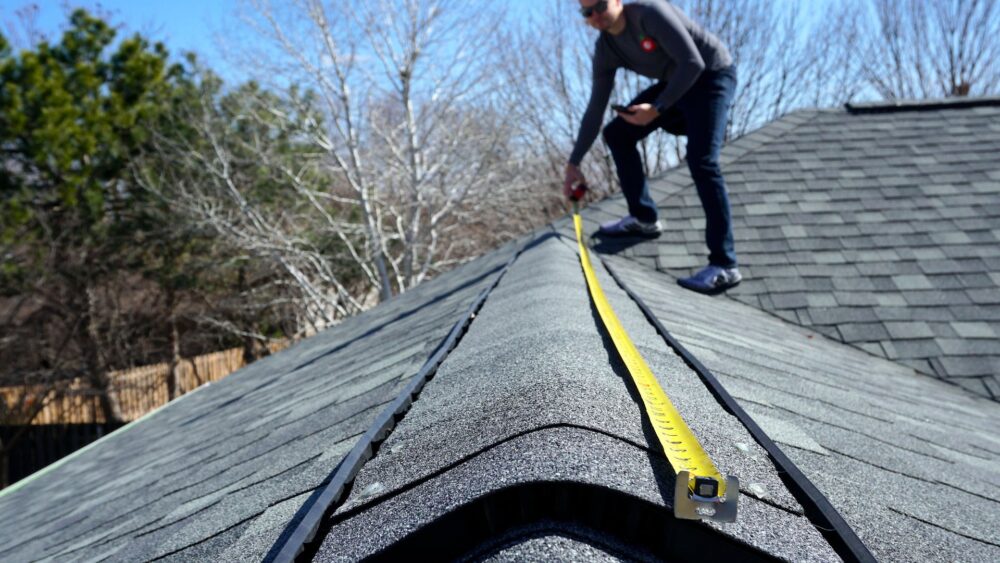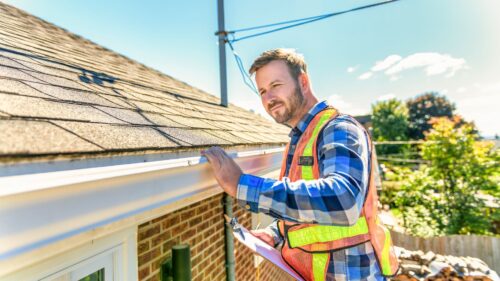Ever wonder why some houses feel like a breath of fresh air, while others are just stuffy? The secret might lie above you – in the attic. Yes, we’re talking about roof ventilation, a game-changer for both your comfort and wallet. With an average ROI sitting pretty at 3800%, ignoring this aspect of home care is like throwing money into the wind. But fear not! Whether you’re deep in the trenches of home renovation or simply curious, understanding the ins and outs of proper roof venting can transform your living space.
What is Roof Ventilation?
What is ventilation, anyway? According to Oxford, ventilation is the “provision of fresh air to a room, building, etc.”
So when we talk about roof ventilation, we’re talking about a system that allows air to circulate through your attic and roof space. So, this nifty feature steps in to keep your home’s temperature and moisture levels just right.
Why Is Proper Roof Ventilation Crucial?
Roofs that don’t have proper ventilation really fail at one of their intended purposes – helping to maintain interior temperatures. Not only is the roof supposed to keep the elements and precipitation out of the house, but it also needs to let hot air escape in the Summer months without letting it in so that the home is as energy-efficient as possible.
Without proper roof ventilation, you could be looking at some serious problems down the line. We’re talking moisture buildup, heat trapped in your attic, and even damage to your shingles and roof structure.
Exhaust Vents vs. Intake Vents
Before covering each type of roof vent available on the marketplace in 2024, let’s first get an overview of the two styles of ventilation in general… Exhaust; Let That Stale Air Out
Exhaust vents, as the name suggests, are designed to let hot, stale air escape from your attic. These are usually installed near the ridge of your roof and can include options like ridge vents, box vents, and turbine vents.
Intake vents, on the other hand, allow fresh, cool air to enter your attic space. These are typically installed along the eaves or soffits of your roof and include options like soffit vents and gable vents.
Active vs. Passive Roof Ventilation Methods
Most roof vents on the market are passive devices that rely on the stack effect, wind, temperature differentials, or some combination of those forces to move air. There also are electrically powered vents capable of moving a great deal of air, such as the roof-mounted models manufactured by Air Vent that can exhaust as much as 1320 cu. ft. per minute (cfm). Powered gable vents can push up to 1620 cfm.
Active roof ventilation uses mechanical systems like attic fans or powered vents to forcibly move air through your attic space. Passive ventilation, on the other hand, relies on natural airflow and the principle that warm air rises to create circulation.
Identifying Poor Air Flow and Heat Buildup
Hot air trapped in your home during the summer, making it difficult to keep your home cool. Trapped hot air causing issues like mold, mildew or ice dams in the winter.
These are just a couple of the signs of poor roof ventilation. If you’ve noticed your energy bills creeping up or your AC working overtime, it might be time to take a closer look at your attic ventilation.
Remember, warm air rises. If that hot air has nowhere to go, it’s just going to sit in your attic and make things uncomfortable (and expensive) for you.
The Role of Insulation in Conjunction with Roof Ventilation
Andre Desjarlais, the Building Envelopes Program Manager at the Oak Ridge National Laboratory, shares some of Rose’s views, and both agree that an effective air-seal below the attic is essential for controlling moisture that could condense on the back side of cold roof sheathing. But Desjarlais thinks that vents do have some value. “From an energy perspective, I’m not sure ventilation is much of a big deal,” he said in a telephone call, “but from a moisture-control perspective, I think it is a big deal.”
Insulation and ventilation work hand in hand to keep your home comfortable and enhance energy efficiency. Insulation helps keep the heat in during winter and out during summer, while ventilation helps regulate moisture and temperature in your attic.
Think of it this way: insulation is like a cozy blanket for your house, and ventilation is like cracking a window to let in some fresh air. You need both for a healthy, happy home.
Incorporating Ridge Vents and Under-Eave Vents
So what’s the best way to improve roof ventilation? The climate you live in and other property factors should be taken into consideration when determining which type of roof vents will provide the most useful functionality.
One effective combination is using ridge vents along the peak of your roof and under-eave (soffit) vents. This allows for a continuous flow of air, with cool air entering through the soffit vents and hot air escaping through the ridge vents.
You can also consider adding attic fans for enhanced air movement, especially if you live in a particularly hot and humid climate. Just make sure they’re properly sized for your attic space.
The intent of roof venting varies depending on climate, but it is the same if you’re venting the entire attic or if you’re venting only the roof deck. In a cold climate, the primary purpose of ventilation is to maintain a cold roof temperature to avoid ice dams created by melting snow and to vent any moisture that moves from the conditioned living space to the attic.
Regulations for Roof Ventilation
When it comes to following building regulations for roof ventilation, it’s important to check with your local building codes and requirements. These can vary depending on where you live and the type of roof you have.
In general, most building codes require a minimum amount of ventilation based on the size of your attic space. This is usually expressed as a ratio, such as 1:150, meaning one square foot of vent area for every 150 square feet of attic floor space.
Roof Ventilation Maintenance
Maintaining your home’s roofing ventilation is especially important in the Midwest because we experience both extremely cold and hot weather. Roofing ventilation options should protect your home from each of these scenarios.
When it comes to choosing the right type of roof vent for your home, there are a few factors to consider. Before anything else, consider the weather and environment you live in. If you live in an area with heavy snow and ice, you’ll want to choose vents that won’t get clogged or allow moisture to enter your attic.
You’ll also want to consider the style of your roof. Some vents, like ridge vents, work best on certain types of roofs. And don’t forget about aesthetics. You want your vents to blend in with your roof, not stick out like a sore thumb.
Simple gable roofs are easy to vent by establishing an unbroken air channel from the eave to the ridge. Hip roofs and roofs that run into a wall are more challenging. Manufacturers offer specialty vents for these situations. “All roof assemblies can be ventilated in some way,” says Dale Walton of CertainTeed. “It may not be balanced or function perfectly, but the attempt is made.”
To calculate the necessary ventilation for your attic space, you’ll need to know the square footage of your attic floor. Once you have that number, you can use the ratio required by your building codes (usually 1:150) to determine how much vent area you need.
For example, if your attic is 1,000 square feet, you’d need about 6.7 square feet of total vent area (1,000 / 150 = 6.7). This should be split between intake and exhaust vents, so you’d need about 3.35 square feet of each type.
DIY vs. Pro Roof Ventilation
It is incredibly important to make sure your home and roof have proper ventilation. The ventilation is good for all of the extra moisture and heat that tends to accumulate in attics. Whether you live in a cold climate or a hot one, the water buildup can cause structural damage and be costly to repair. Whenever possible, it’s important to start with the best roof ventilation that works for your budget.
While there are certainly DIY options for improving your roof ventilation, sometimes it’s best to call in the pros. A skilled roofing pro can take a look at your home, figure out what it really needs, and suggest the perfect fixes.
They’ll take into account factors like your climate, roof style, and attic size to create a customized ventilation plan. With the right tools and know-how at their disposal, they’ll make sure your home is not just safe but also has great airflow.
There’s a lot of back-and-forth about whether letting off steam really does us any good. Builders go to a lot of trouble to vent the roof. Whether it’s effective or not depends in part on exactly what a builder is trying to vent—an unconditioned attic where the insulation and air barrier are immediately above the living space of the house, or the roof deck when the air barrier and insulation have been moved to the roof plane.
One common misconception about roof venting is that more is always better. While adequate ventilation is important, over-ventilating your attic can actually cause problems like moisture buildup and energy loss.
Another misconception is that roof vents are a one-size-fits-all solution. In reality, the type and amount of ventilation your home needs depends on a variety of factors, from your climate to the design of your roof.
So before you start drilling holes in your roof, make sure you’ve done your research and consulted with a professional. Knowing just a bit can really help in making sure your home stays fresh and breezy.
Roof Ventilation FAQs:
What is the best way to ventilate a roof?
Mixing ridge and soffit vents creates an efficient airflow, pulling cool air in and pushing hot air out.
What ventilation is required for a roof?
Your attic needs 1 square foot of vent space per 150 square feet of attic floor for balanced air flow.
What happens if a roof is not vented?
Lack of ventilation traps heat, hikes energy bills, damages shingles, and leads to mold growth. It’s bad news all around.
What is the best type of roof for ventilation?
A steep slope with continuous ridge and soffit vents offers optimal conditions for effective natural ventilation.
Conclusion
In wrapping up our rooftop journey, it’s clear that roof ventilation isn’t just another item on your homeowner checklist; it’s pivotal for maintaining a healthy living environment and keeping those energy bills in check. Get started today by securing your free quotes!



